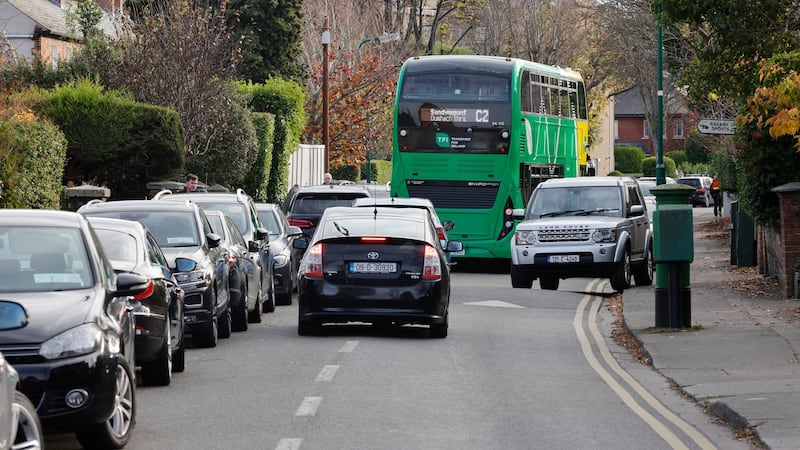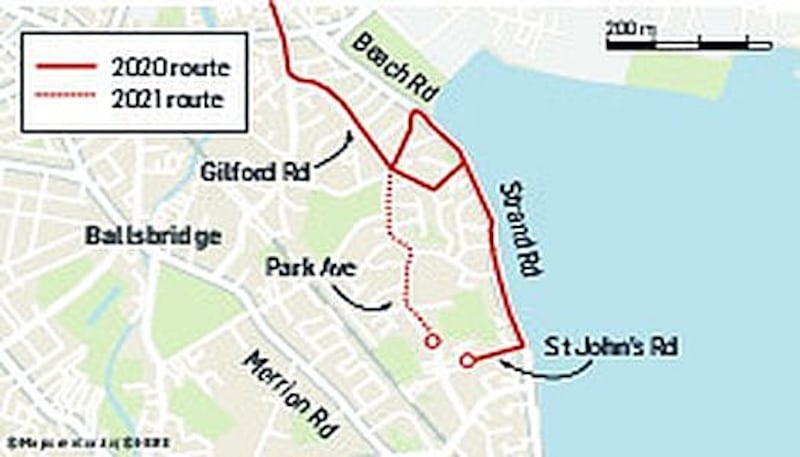A group of Sandymount residents is appealing to the National Transport Authority (NTA) to urgently alter the new BusConnects C-Spine route which only came into service on Sunday.
The C-Spine is the second of the redesigned Dublin bus network routes to begin operating, with buses running from Maynooth, Celbridge, Leixlip, and Lucan, through the city to Ringsend and Sandymount. It follows the introduction last June of the H-Spine from Howth and Malahide.
While the C-Spine routes from west Dublin remain largely as published by the NTA in 2020, the Sandymount end of the route has been altered to remove buses from Strand Road.
The change has been introduced to facilitate Dublin City Council's plans to begin a one-way system on Strand Road to make space for a cycle path. The High Court in July ruled the cyclepath required planning permission. The council is appealing the court's decision.
Strand Road not used
Sandymount residents said they only realised in recent weeks the BusConnects plan had been changed to use Gilford Road and Park Avenue instead of Strand Road.
"Park Avenue is a narrow residential road and at some points it is physically impossible for two buses to pass each other without one mounting the kerb. Under this new BusConnects route there will be buses every two minutes at peak times and approximately every four minutes after that. That sort of frequency is unthinkable," said Kevin Byrne of the Park Avenue Action Group.
Up to the middle of November maps on the NTA’s website showed the C-Spine route using Strand Road, said Mr Byrne.
“We have had no engagement on this with the NTA. We made submissions to the BusConnects consultation on the basis of a route that no longer exists. We presumed that, given the courts quashed the council’s cycle route plan, the NTA would use Strand Road.”
The group said because Sandymount is the route’s terminus, buses could use a loop system so they would run in one direction only on Park Avenue. “Without mitigation measures Park Avenue will become a service road for buses hammering up and down willy-nilly. It will be carnage,” said Mr Byrne.
Fine Gael Cllr Paddy McCartan said he would be calling on council management to liaise with the NTA to resolve the issue.
“It makes sense for the route to revert to Strand Road. The whole purpose of BusConnects is to serve as many areas as possible. Excluding Stand Road is excluding half of Sandymount and causing a huge safety issue on narrow Park Avenue.”

An NTA spokesman said new alignment appears on the Transport for Ireland website and in materials distributed to households in the area "in recent weeks".
Bus routes, which are being discontinued under the network redesign, had been diverted from Strand Road to Park Avenue earlier this year and it was the NTA’s preference to continue with this flow for the new C routes, instead of using a one-way loop-back system
“Experience shows that, wherever possible, having bus routes use the same roads in both directions is preferred by the majority of passengers [and prospective passengers] as it provides a simpler, easier-to-use network,” he said.
“As always, operations around the implementation of C-Spine will be closely monitored and appropriate actions taken where necessary.” The NTA has been engaging with council officials, he said. “We understand that the legal process in respect of the proposed cycle scheme is ongoing.”
The network redesign involves scrapping the current numbering system for all buses. A new lettering system from A to H will identify eight “spines” through the city, with buses running every four to eight minutes. Numbers will be used to indicate different branches of a spine.
What is the new fare?
Separately a new 90-minute fare, which will allow passengers to transfer between public transport services in Dublin for €2.30, came into operation on Sunday.

Passengers can use Dublin Bus, Luas and most Dart, commuter rail and Go-Ahead Ireland services in Dublin within 90 minutes of initial departure, without incurring extra charges.
The TFI 90-minute fare will be €2.30 for adults and students when using their Leap card during a promotional period to remain in place until the end of March, 2022. The price will then increase to €2.50.
A new flat 80 cent Leap card fare for children has also been introduced.











